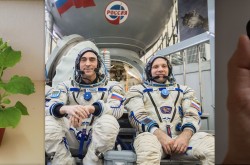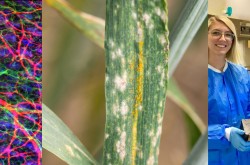3 things you should know — July edition


Meet Renée-Claude Goulet, Jesse Rogerson, and Kyrke Gaudreau.
This all-star trio works as Ingenium’s science advisors, providing expert advice on key subjects relating to our three museums — the Canada Agriculture and Food Museum, the Canada Aviation and Space Museum, and the Canada Science and Technology Museum.
In this new monthly blog series, Ingenium’s science advisors offer up three quirky nuggets related to their area of expertise. For the July edition, they tackled how blockchain technology is impacting the agri-food industry, why David Saint-Jacques is actually slightly younger after his six months in Space, and why artificial intelligence has the power to both help and hurt us in the battle against climate change.

A disruptive technology lands in the agri-food industry
Bitcoin, Ethereum, Litecoin…you’ve probably heard about cryptocurrency in the news. Lately, the engine that allows these currencies to exist — blockchain technology — has been making headlines in the agri-food industry. According to experts, the potential of this technology could be enormous in agri-food traceability.
Just imagine a consumer at the grocery store opening a Web site on their smartphone and “scanning” a code on a package of pork loin. Immediately, the entire history of the product shows up on their screen: the arrival date at the store, the location and time the animal was slaughtered, the farm where it was raised, and even the medical treatments it received. Incredible! This is not a very distant future, it is already happening in Taiwan with the company OwlTing.
For this type of traceability to be possible, everyone involved in the system must participate in the collection and distribution of data. In a way, a blockchain is like a huge Excel spreadsheet that grows with each operation recorded. Every operation represents a “block” in which the information is permanent and not editable. This table, or ledger, is available to the public and saved in small pieces on all computers participating in a network. Essentially, the blockchain, or ledger, securely links all existing data (made available on the Internet) of a given product, in one place.
Every agriculture industry can have their own blockchain system to enhance traceability. The benefits would include reduced losses at the supply chain level, optimizing global distribution, as well as improving consumer trust. Such a system would also allow us to trace the origins of foodborne illness epidemics in a few minutes instead of a few days. In fact, Wal-Mart has recently teamed up with IBM to launch a pilot project using blockchain tech to enhance food safety in their distribution chain.
Fans of the technology will paint you a rosy picture where we see the end of inequality in the distribution of resources, and foodborne illness epidemics are virtually eliminated. But several questions remain: is it useful for the consumer to have access to such levels of details on farming operations, without context? Will producers be reluctant to use a technology which involves a lot of data entry?
This technology’s potential to improve our lives, including public health care, is undeniable. But every technology has an unpleasant side, too. So we can expect that, in the long term, adopting this technology will make big waves in local and international markets, and in food safety.
By Renée-Claude Goulet

How David Saint-Jacques gained 0.006 seconds
Back in 1905, Albert Einstein published his Special Theory of Relativity, which laid out, among other things, how an object moving at high speeds will experience time moving slower relative to an object moving at a slower speed. This is called time dilation and the theory goes on to say that the faster the object is moving, the more pronounced the effect will be.
Fast forward to June 24, 2019 at 10:47 p.m.: Canadian astronaut David Saint-Jacques returns to Earth from the International Space Station (ISS). Over the last 6.5 months, Saint-Jacques has been living and working in a zero gravity environment; he has completed 3,264 orbits of the Earth, and travelled a distance of 139,096,495 km (that’s almost the distance from the Earth to the Sun!).
The ISS sits in Low Earth Orbit (LEO), which is about 400 km above the surface of the Earth. In order to remain at that height without falling back to Earth, the ISS must travel very quickly; it’s average velocity is about 28,000 km/h. That’s 280x faster than driving on the Trans-Canada!
Since Saint-Jacques has been travelling at such a high speed, will the effects of time dilation be noticeable? Crunching the numbers, I found that according to clocks on Earth, Saint-Jacques spent 203 days, 4 hours, and 16 minutes in Space, or 17,554,560 seconds total. However, according to the clocks on the ISS, he spent 17,554,559.9941 seconds in space. That is a difference of 0.006 seconds! Meaning if Saint-Jacques had spent that 6.5 months on Earth instead of in space, he’d be 0.006 older than he is now. Science is WEIRD!
Okay so cool, Saint-Jacques is now younger by 0.006 seconds than his hypothetical Earth-bound self. The flip side is, unfortunately, living and working in a zero gravity environment for such a long period of time has some dramatic health effects: his muscles are weaker, bones are less dense, his heart is weaker, and arteries more stiff; he even has a higher risk of cancer. So while Saint-Jacques may have experienced slightly less time than the rest of us, the effects of traveling to space have taken away any benefit he might have enjoyed. Read more about Saint-Jacques’ road to recovery in this Q-and-A with
Raffi Kuyumjian, the Canadian Space Agency's doctor.
By Jesse Rogerson

Towards a sustAInable future?
Artificial intelligence (AI) has tremendous potential to help us in the fight against climate change. In fact, a recent MIT Article proposed 10 ways AI can reduce emissions. Let’s look at three of them.
Anyone who has used Google Maps, ridden in an Uber, or ordered a package from Amazon has experienced the power of AI to optimize routes, logistics, and supply chains. From algorithms that plan your route for you to analytics that predict your future purchases, AI is allowing companies to be as efficient as possible, and in doing so, reduce emissions.
AI will also play a key role in getting more electric vehicles (EVs) on the road. Right now, grid operators are hesitant about whether the grid can handle additional EVs (if everyone plugged in their EV at the same time, there would be a surge in demand). However, with machine learning and big data, algorithms will basically turn your EV and all the others into large batteries (called Virtual Power Plants) that will actually make the grid more stable.
Finally, AI is already being used to speed up research and development into new solutions, such as solar fuels, which create clean fuel from just water, sunlight and CO₂. This happens because AI can handle much more data than humans can, and in doing so can find correlations at a faster pace. Secondly, and much creepier, generative algorithms are becoming creative in their own regard, and are dreaming up new compounds and designs that humans never could.
While AI promises many benefits in the fight against climate change, there is one major drawback: all that data processing uses a lot of energy. In fact, researchers just showed that training a single AI model emits as much greenhouse gases as five cars over their entire lifetime! That’s a lot, especially when you think how prevalent new models will be in all aspects of our lives. Just as much as AI will help us reduce our carbon footprints, we need to simultaneously reduce the footprint of AI.
So should we stop using AI to fight climate change? Absolutely not! AI will be a key player moving forward. However, we must remember that being smarter sometimes means not doing something. So, instead of resting easy knowing that Amazon has optimized the delivery of your package to you, the more important question is whether you needed to buy that item in the first place. That’s a decision only you can make, although perhaps someone will develop an algorithm to decide for you...
By Kyrke Gaudreau













